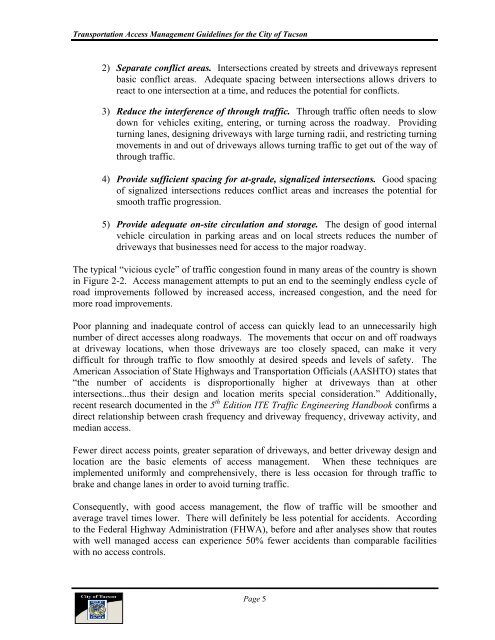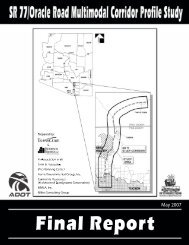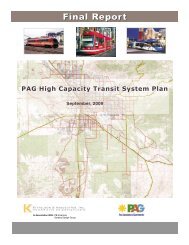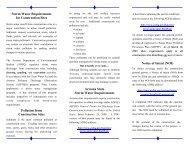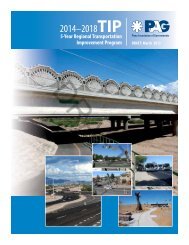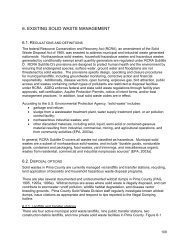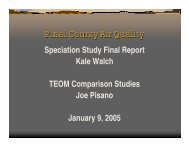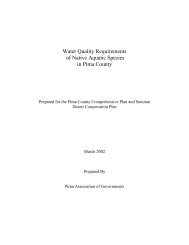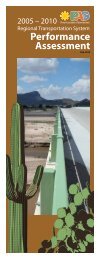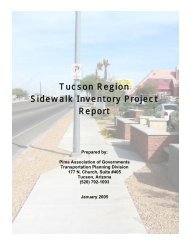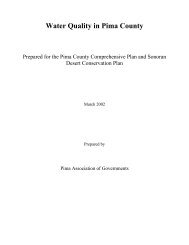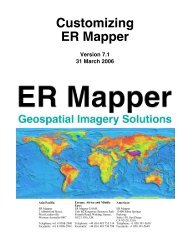Transportation Access Management Guidelines for ... - City of Tucson
Transportation Access Management Guidelines for ... - City of Tucson
Transportation Access Management Guidelines for ... - City of Tucson
Create successful ePaper yourself
Turn your PDF publications into a flip-book with our unique Google optimized e-Paper software.
<strong>Transportation</strong> <strong>Access</strong> <strong>Management</strong> <strong>Guidelines</strong> <strong>for</strong> the <strong>City</strong> <strong>of</strong> <strong>Tucson</strong><br />
2) Separate conflict areas. Intersections created by streets and driveways represent<br />
basic conflict areas. Adequate spacing between intersections allows drivers to<br />
react to one intersection at a time, and reduces the potential <strong>for</strong> conflicts.<br />
3) Reduce the interference <strong>of</strong> through traffic. Through traffic <strong>of</strong>ten needs to slow<br />
down <strong>for</strong> vehicles exiting, entering, or turning across the roadway. Providing<br />
turning lanes, designing driveways with large turning radii, and restricting turning<br />
movements in and out <strong>of</strong> driveways allows turning traffic to get out <strong>of</strong> the way <strong>of</strong><br />
through traffic.<br />
4) Provide sufficient spacing <strong>for</strong> at-grade, signalized intersections. Good spacing<br />
<strong>of</strong> signalized intersections reduces conflict areas and increases the potential <strong>for</strong><br />
smooth traffic progression.<br />
5) Provide adequate on-site circulation and storage. The design <strong>of</strong> good internal<br />
vehicle circulation in parking areas and on local streets reduces the number <strong>of</strong><br />
driveways that businesses need <strong>for</strong> access to the major roadway.<br />
The typical “vicious cycle” <strong>of</strong> traffic congestion found in many areas <strong>of</strong> the country is shown<br />
in Figure 2-2. <strong>Access</strong> management attempts to put an end to the seemingly endless cycle <strong>of</strong><br />
road improvements followed by increased access, increased congestion, and the need <strong>for</strong><br />
more road improvements.<br />
Poor planning and inadequate control <strong>of</strong> access can quickly lead to an unnecessarily high<br />
number <strong>of</strong> direct accesses along roadways. The movements that occur on and <strong>of</strong>f roadways<br />
at driveway locations, when those driveways are too closely spaced, can make it very<br />
difficult <strong>for</strong> through traffic to flow smoothly at desired speeds and levels <strong>of</strong> safety. The<br />
American Association <strong>of</strong> State Highways and <strong>Transportation</strong> Officials (AASHTO) states that<br />
“the number <strong>of</strong> accidents is disproportionally higher at driveways than at other<br />
intersections...thus their design and location merits special consideration.” Additionally,<br />
recent research documented in the 5 th Edition ITE Traffic Engineering Handbook confirms a<br />
direct relationship between crash frequency and driveway frequency, driveway activity, and<br />
median access.<br />
Fewer direct access points, greater separation <strong>of</strong> driveways, and better driveway design and<br />
location are the basic elements <strong>of</strong> access management. When these techniques are<br />
implemented uni<strong>for</strong>mly and comprehensively, there is less occasion <strong>for</strong> through traffic to<br />
brake and change lanes in order to avoid turning traffic.<br />
Consequently, with good access management, the flow <strong>of</strong> traffic will be smoother and<br />
average travel times lower. There will definitely be less potential <strong>for</strong> accidents. According<br />
to the Federal Highway Administration (FHWA), be<strong>for</strong>e and after analyses show that routes<br />
with well managed access can experience 50% fewer accidents than comparable facilities<br />
with no access controls.<br />
Page 5


